Amiga Anywhere-compatible devices
The primary argument for using and developing for the Amiga Anywhere
digital environment is the ability to use the same software on devices
that use different architectures, processors and are intended for
different purposes. It should be possible to run an Amiga Anywhere
game on any operating system if the Tao intent virtual machine has
been ported to that environment. This page outlines the hardware
on which the Amiga Anywhere/Amiga DE software has been demonstrated.
Video demonstrations
Sharp Zaurus
Psion netBook
Compaq iPAQ
Vadem Clio
IPM-Net's Myfriend
Gateway Connected Touch Pad
o2 Windows Pocket XDA
Show Demonstrations
StrongARM-based laptop
Sega Dreamcast
LSI Logic set-top box
Armed Computing Prospector
StrongARM-based handheld
200MHz mobile gaming platform
MTV set-top box
Sharp Zaurus

In an handheld market dominated by Palm and Windows platforms,
Sharp introduced the Linux-based Zaurus SL-5000. Launched in Japan
in December 2000 for the equivalent of $475 US dollars, the Zaurus
was the first handheld designed to appeal to the consumer market.
The Zaurus boasted functionality considered extraordinary - MP3
playback, MPEG-4 movie decoder, and hand-writing recognition. It
also offered e-mail and Internet connectivity when connected to
an NTT DoCoMo cellular modem card. It won numerous computing awards
from the computing industry, most notably being declared the 'Most
Excellent Product' (sic) of 2001 by Japanese magazine, 'Business
Computer News'.
On April 1st 2001, Sharp were announced as the third Amiga Inc.
partner. In a press announcement, Amiga Inc. indicated they would
develop AmigaDE-based 'content' for the American launch of the Sharp
E1-M1.

In an interview, Hiroshi Uno, general manager of Sharp's mobile
systems division, indicated the company intended to sell 1 million
PDAs worldwide in one year. To gain a significant share of the PDA
market the company has announced several partnerships, including
Amiga Inc, to produce cross-platform solutions for the device. The
developer release features the ARM Linux 2.4.6 kernel, with Russell
King's patches and Nicolas Pitre's StrongARM patches. The embedded
Linux GUI derivative, TrollTech's Qt Palmtop Environment (QPE) is
also used, providing graphical features on the tiny display. For
synchronizing with Windows PCs the Qt Palmtop Center and Intellisync
has been provided, allowing the user to sync with MS Outlook. Insignia
Solution's Jeode, an implementation of Sun's PersonalJava, is also
offered.
In their press release,
Amiga Inc. indicated that they would be developing 'new content
or adapt existing content for PDA applications' in the American
market. However, the delayed development of the Amiga DE forced
Sharp to abandon their plans to bundle the Amiga software. Although
it remains possible to reflash the device to use Amiga software,
its absence in the final version has sacraficed a potentially lucrative
market and will place greter emphasis upon Amiga Inc's relationship
with Microsoft to gain market dominance.
Unfortunately the Sharp Zaurus deal was abandoned, allegedly as
a result of Amiga Inc's inability to produce the software support
in the required timeframe. Though a disk image can be flashed to
the Zaurus, allowing owners to play Amiga games, it has largely
been ignored by the mainstream user.
Relevant Pages
Zaurus SL-5000 Announcement
| Zaurus SL-5000 Specifications
| Zaurus Elate screenshots
Screenshots
An Amiga game running on the
Zaurus (24k)
External Links
Linux
Devices review of the SL-5000 Developer version
InfoSync
review of the SL-5000D
Psion netBook
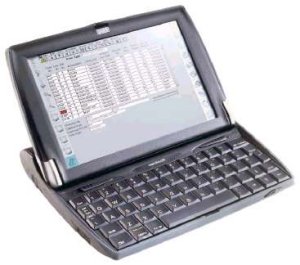
Psion was revealed as the fourth PDA developer to licence to Amiga
DE on April 1, 2001. It was soon apparent the partnership was an
April fools joke played on Amiga Inc. - Psion announced they were
exiting
the consumer PDA market a few months later. The Psion-Amiga
deal may be nonexistent, but it does not prevent the Amiga DE being
run on Psion handhelds in an unofficial capacity. The Psion series
7 uses the EPOC operating system, running on the StrongARM SA1100
processor.
Fleecy Moss mentions the Psion
deal
Watch Amiga DE running on the Psion
Series 7 (MPEG1, 1.7MB)
Geek.com's
review of the Series 7
Compaq iPaq
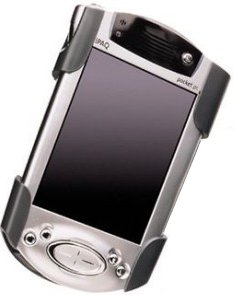
The Compaq iPaq series is a multimedia-centric PDA with limited
expansion capabilities. The series is designed around the Intel
Strong ARM 32-bit processor and offers the standard Windows for
Pocket PC software - Pocket Outlook, Internet Explorer, Word, Excel
and Media Player.
Handhelds.org Compaq
page
Watch Amiga DE running on the Compaq
iPAQ (MPEG1, 2.6MB)
Vadem Clio
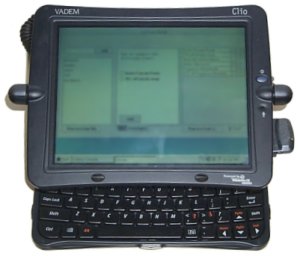
The Clio is a Windows CE based mobile PC that can perform three
functions - it can be a conventional laptop, a tablet or a presentation
display. The device is powered by an 84 mhz NEC Vr4111 MIPS processor,
with 16MB RAM. The unique design was provided by Frog Design - a
company many Amiga owners will remember for their work on the Amiga
Mind Walker project. Pen Computing describe the Clio as "one
of the most stunning computer designs to appear in a very long time.
It looks like nothing else and may just be the beginning of a new
class of computers."
Watch Amiga DE running on the Vadem Clio (MPEG1, 1.68MB)
Vadem web site
FrogDesign
on the Vadem Clio
Pen
Computing review
IPM-Net's Myfriend
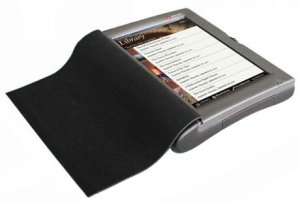
The IPM-Net Myfriend is a portable eBook reader designed around
the MIPS RISC R3000 processor. The eBook functionality is provided
through use of Microsoft Reader, running on the Windows CE 3.0 operating
system. The device offered significantly better screen resolution
and more memory in comparison to similar devices at the time of
release. However, this came at a price of 1,200 US dollars on release.
Watch Amiga DE running on the
IPM-Net Myfriend (MPEG1, 1.53MB)
Myfriend
System specifications
Electronic
Webs review of the Myfriend
Gateway Connected Touch Pad
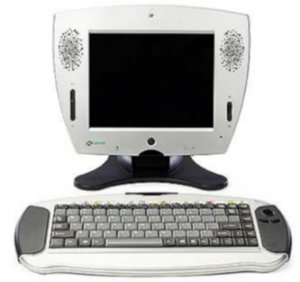
The 'Gateway Connected Touch Pad' is the product of the technology
investigation performed by the Amiga subsidiary at Gateway
and, in many ways, may be considered a descendent of the cancelled
Amiga MCC project. The iApplicance
is built around a 400 MHz Transmeta 3200 processor, 128MB RAM and
32MB CompactFlash storage memory and comes installed with Mobile
Linux version 2.4. Internet connectivity is provided through AOL,
providing a safe haven for Internet newcomers away from the scarier
sections of the Internet (comp.sys.amiga.advocacy). The machine
was dropped after Gateway management lost faith in the convergence
maket. Unfortunately, Gateway no longer sell the device, so they
are increasingly difficult to locate.
Watch Amiga DE running on the
Gateway Touch Pad (MPEG1, 1.59MB)
iAppliance
Web review the Touch Pad
Transmeta
Zone: The Gateway Touch Pad Revisited
o2 Windows Pocket XDA
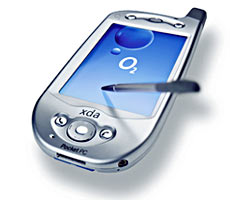
Bill McEwen announced a version of the Amiga Anywhere would be
released for the o2 XDA at the AmiWest 2002 show (29th July, 2002).
The Windows Pocket 2002 XDA - the version of the XDA to which he
was referring - had the following specification:
| CPU |
Intel Strong ARM 206MHz |
| Display |
Reflective TFT display (240x320 pixel), 4096 colours |
| Memory |
32MB RAM |
| OS & Software |
Microsoft Windows for Pocket PC
Pocket Outlook
Pocket Internet Explorer
Pocket Word
Pocket Excel
Microsoft Windows Media Player 8 for Pocket PC |
| Dimensions |
18 x 73 x 129mm |
| Weight |
201 g |
| Input/Output |
USB |
ZDNet
Review of the XDA
Strong ARM-based laptop
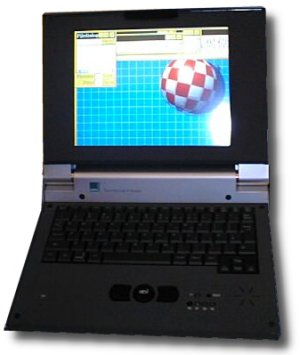
Bill McEwen demonstrated a touchscreen laptop, manufactured by
ARM running the Amiga DE (called AMIE
at the time). Press reports suggest it was designed by Mick Tinker
of BoXeR fame.
CUCUG, The Status
Register August, 2000 - Show report
Sega Dreamcast
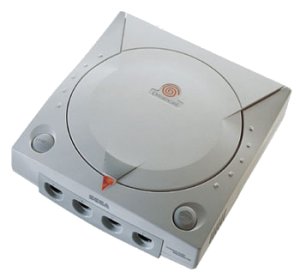
An early development version of the AMIE operating environment
(later called Amiga Anywhere) was demonstrated on the Sega Dreamcast
at the Java One show in 2000. Tao-Group announced support of the
Hitachi SH-4 processor - the CPU used by the Dreamcast - in a March
1999 announcement.
Tao's
Engine for Running JavaTM Technology now available on Hitachi, MIPS
and NEC Processors (archive.org)
LSI Logic set-top box
Amiga Inc. allegedly used their contacts made through Tao-Group
to demonstrate an early version of the Amiga operating environment
on an LSI Logic set-top box at the Java One conference, 2000.
Amiga President
& CEO, Bill McEwen Interviewed on CNNfn
Armed Computing Prospector
Amiga Inc. demonstrated the AMIE operating
environment running under Linux and Windows on Armed Computing's
Prospector notebook and various non-descript x86 machines at the
Java One conference in 2000.
Amiga President
& CEO, Bill McEwen Interviewed on CNNfn
StrongARM-based Handheld
In a presentation for the Neuss show in 2000, Bill McEwen indicated
a handheld device was in internal use to demonstrate the AMIE
operating environment to interested parties. The device utilizes
a StrongARM CPU running at 250 Mips, and includes a colour screen
and Sony Memory Stick port. Bill McEwen boasted that this was developed
in just one week.
200MHz mobile gaming platform
At the AmiWest 2001 show (July 28, 2001) in California, Bill McEwen
announced an "extremely large, multi-billion dollar organisation"
had contacted Amiga Inc. to discuss using the Amiga DE on a top-secret
product. Although he would not name the company, he suggested the
device specification would be somewhere between Nintendo's GameBoy
Advance and a traditional game console. It would contain a 200MHz
processor, "plenty of RAM", and a target price of under
200 US dollars.
MTV set-top box
In a Amiga UGN webcast at the AmiWest 2002 show (July 30th 2002),
Bill McEwen indicated a deal had previously been struck with MTV
to develop the Amiga DE for their set-top box. However, the market
recession resulted in the set-top box being cancelled and the deal
was abandoned.
BACK
Last Update: 10/06/2006
|












